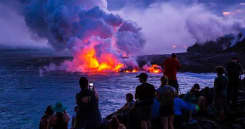When you think of Hawaii you probably think of white sandy beaches, azure blue waters, and a colorful tradition of life in paradise in the middle of the Pacific Ocean. These are, indeed, part of the Islands’ landscape.
However, part of Hawaii’s island chain looks more like the surface of a distant planet – dark, steamy, a beautiful orange glow just over the horizon. This is Kilauea Volcano which has been erupting non-stop since 1983.
The beautiful islands of our 50th state were created by volcanic activity below the ocean’s surface. Over the centuries, volcanoes spewed lava and expanded the size of the islands that make up this world of tropical beauty. Today, adventure seeking travelers visit Hawaii Volcanoes National Park for a close-up view of this spectacular natural phenomenon. A stop at the Hawaiian Volcano Observatory provides the latest on the volcanos’ activities and where to get the best view of lava flowing over land down into the Pacific.
How to Get There
Volcanoes National Park is located on the Big Island of Hawaii. To get there from Hilo, drive 30 miles southwest on State Highway 11 (about a 45 minute drive).
If you’re staying in the Kailua-Kona District, take Route 11 southeast for 96 miles. It’s about a two-hour drive through some of the most beautiful scenery you’ve ever seen.
Start with a visit to the Kilauea Visitor Information Central building. The park is open 24 hours a day year ‘round and the visitor center is open from 9:00 AM until 5:00 PM. Here, you’ll receive information and a map of the hiking trails that get you up close to the rim of a bubbling cauldron of red hot lava.
For the less adventurous, or for family fun, there are ranger-led activities that are safe, fun, and educational under the guidance of an experienced park guide.
Enjoy a 25-minute film of the volcanoes of Hawaii and discover how the island chain continues to evolve across the centuries. “Born of Fire, Born of Sea” is a film that will prepare you for the adventure of a lifetime while describing the activity taking place just below your feet.
It’s also important to learn the safety rules of day hikes in the park. Remember, you’ll be hiking near potentially dangerous terrain and a lesson in safety is a must, even for experienced trekkers.

How far has the damage from the recent Kilauea eruption stretched?
More infoDay Hikers: What to Bring
There are well-marked trails from an easy stroll to a difficult ascent – one to suit your fitness level and spirit of adventure. A word of warning: don’t try to cover more ground than you think you can. Don’t forget, you have to do a round-trip trek. Experts at the Hawaii Volcanoes National Park strongly recommend that you bring the following on your day trip to the park:
• 2-3 quarts of water per hiker
• sturdy boots with closed toes. No sandals or flip-flops.
• long pants in case you slip on the glassy surface
• sunscreen
• a broad-brimmed hat to keep the sun off your face
• a flashlight, even if you plan to be back before sundown
• a first-aid kit
• heavy duty leather gloves to protect your hands in a fall If you plan to be out for a long trek, you’ll want to bring plenty of high-energy foods to keep your body fueled and ready for adventure.
Volcano Hiking Safety Tips
If you’re an inexperienced hiker, it’s easy to forget the dangers of trekking near hot lava. What looks like solid ground may, in fact, be cooling lava.
Hikers most often are injured in falls. The surface of a cooling lava field can be covered with glass shards that can cut hikers and leave them stranded.
Always plan for more time to get where you’re going. If a park ranger tells you it’s a three-mile walk, estimate your time for a five-mile walk. The terrain around an erupting volcano is rugged and difficult to cross.
Don’t stand near steep cliffs that hang out over the water. These cliffs may be brittle and break, sending hikers into the crashing waves below. NOTE: If you should fall into the ocean you can’t climb out. The cliffs are jagged and steep so be careful.
Stay off the beaches around an active volcano. The ground below the sand may be unstable and cause what’s called a “bench collapse” sending hikers into a pit of sand.
Stay out of the water. Molten lava travels underwater and you might step on it. Even cooled lava is jagged and dangerous.
Move inland quickly if you hear unusual noises like creaks and groans from below your feet. These sounds may be a sign that a collapse is imminent.
Stay on marked trails for safety.
Be sure to tell friends or companions of your plans for the day in case you get lost. What time do you expect to return?
Hawaii Island Recovery can help
Trekking through the lava fields of Hawaii Volcano National Park will present an array of the beauty of our world. While visiting the Big Island, please stop in at Hawaii Island Recovery – an eight-bed facility designed to lift the veil of a substance-induced haze and bring the beauty of Hawaii into clear focus.
It’s one vacation filled with adventure and a brighter future for you and your loved ones. Call Hawaii Island Recovery today and see the beauty all around you.
 Hawaii Island Recovery
Hawaii Island Recovery 










